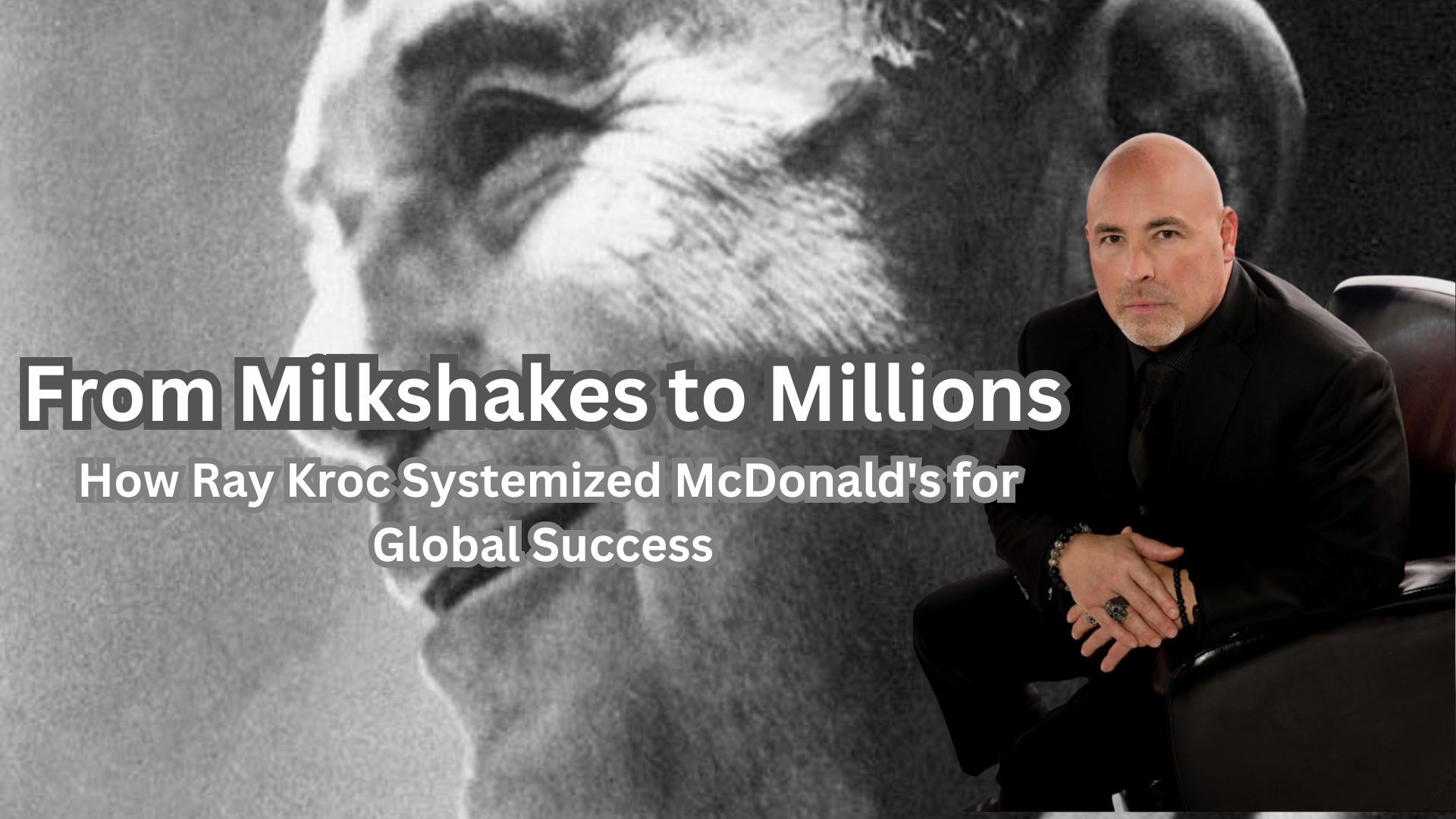If you follow my podcast, “The Chairman Project With Jason Sisneros,” you know how passionate I am about a principle that is crucial for business success: the importance of systems and processes. Week after week, I’ve shared insights, stories, and strategies with my listeners, emphasizing how implementing solid systems can transform a struggling business into a thriving one. It’s a topic I’m passionate about because I’ve seen firsthand how the right processes can streamline operations, boost productivity, and pave the way for sustainable growth. As I’ve delved deeper into this subject, I’ve found myself repeatedly drawn to the remarkable story of Ray Kroc and his systematization of McDonald’s – a story that perfectly illustrates the power of well-designed systems in building a global empire.
The Genius of Ray Kroc
Ray Kroc, the man who built McDonald’s into a global fast-food juggernaut, didn’t just change the way America eats – he revolutionized the very concept of franchising through his relentless focus on systematization.
His vision transformed not only the fast-food industry but also left a permanent mark on American business culture. Kroc’s approach to standardization and quality control became a blueprint for successful franchising across various sectors. He understood that the key to rapid expansion wasn’t just about selling more burgers, but about creating a replicable system that could deliver consistent quality at scale.
Kroc’s genius lay in his ability to see beyond the immediate challenges of running a restaurant. He envisioned a future where the Golden Arches would be a symbol of reliability and consistency, whether you were in California or Connecticut. This required a level of operational precision and standardization that was unprecedented at the time.
His innovations extended far beyond the kitchen. Kroc revolutionized supply chain management, real estate acquisition, and employee training in the service industry. He created a comprehensive system that covered every aspect of the business, from the temperature at which fries should be cooked to the exact words employees should use to greet customers.
This systematic approach not only enabled McDonald’s meteoric rise but also set new standards for efficiency and consistency in the broader business world. Companies in various industries began to adopt elements of Kroc’s system, recognizing the power of standardization in building a scalable business model.
Let’s dive into Kroc’s journey and explore how his systematization strategies can be applied to modern businesses.
The McDonald’s Origin Story
Contrary to popular belief, Ray Kroc didn’t found McDonald’s. In 1954, at the age of 52, Kroc was a milkshake mixer salesman when he stumbled upon a small but efficient hamburger stand in San Bernardino, California. This restaurant, owned by brothers Dick and Mac McDonald, had streamlined their menu and operations to serve customers quickly and efficiently.
Kroc saw potential where others saw just another burger joint. He envisioned a nationwide chain of restaurants that could replicate the McDonald brothers’ efficient system. In 1955, he convinced the brothers to let him franchise the McDonald’s concept across the country.
The Birth of a System
From the very beginning, Kroc understood that the key to successful expansion was systematization. He didn’t just want to open more restaurants; he wanted to create a replicable model that could ensure consistency across all locations.
- Standardized Operations: Kroc developed detailed operations manuals that outlined every aspect of running a McDonald’s restaurant. These manuals covered everything from how to cook fries to how to mop the floors. This ensured that every McDonald’s, regardless of location, operated in the same efficient manner.
- Quality Control: Kroc was fanatical about maintaining quality across all restaurants. He implemented strict quality control measures for ingredients and finished products. This included surprise inspections and rigorous standards for food preparation and presentation.
- Uniform Restaurant Design: Kroc understood the power of visual consistency. He standardized the restaurant layout and design, creating the iconic Golden Arches that would become recognizable worldwide. This uniformity helped build brand recognition and customer trust.
- Comprehensive Training: Kroc established Hamburger University in 1961, a training facility designed to teach franchisees and managers the McDonald’s system. This ensured that every person involved in running a McDonald’s restaurant was thoroughly versed in the company’s methods and standards.
- Supplier Relationships: Kroc built strong relationships with suppliers, often helping them to grow alongside McDonald’s. This allowed for consistent ingredient quality and supply chain efficiency across all locations.
The Impact of Systematization
Ray Kroc’s relentless focus on systematization became the cornerstone of McDonald’s unprecedented growth and success. This approach allowed the company to expand rapidly while maintaining the consistency that became synonymous with the McDonald’s brand.
- Late 1950s to early 1960s: McDonald’s saw rapid initial expansion, selling millions of hamburgers and opening numerous locations across the United States.
- 1960s: The company continued its aggressive growth strategy, establishing hundreds of restaurants nationwide.
- 1970s-1980s: McDonald’s took its successful model global, expanding into international markets and becoming a worldwide brand.
- Present day: McDonald’s operates tens of thousands of locations spanning over 100 countries, serving millions of customers daily.
This remarkable growth trajectory was made possible by the systems Kroc put in place. His approach ensured that whether a customer visited a McDonald’s in New York or New Delhi, they would receive the same quick service, consistent food quality, and familiar restaurant experience.
Kroc’s systematization went beyond just food preparation and service. It encompassed every aspect of the business:
- Real Estate: Developing a system for identifying prime locations.
- Supply Chain: Creating a robust network of suppliers who could meet McDonald’s exacting standards across a growing number of locations.
- Marketing: Standardizing marketing approaches to ensure brand consistency across markets.
- Franchising: Implementing a franchising system that allowed for rapid expansion while maintaining strict control over operations and quality.
The impact of this systematization extended far beyond McDonald’s itself. It revolutionized the entire fast-food industry and influenced business practices across various sectors. Many companies have since adopted similar approaches to standardization and systematization, aiming to replicate McDonald’s success in scaling operations while maintaining consistency.
Kroc’s systems created a replicable business model that worked across cultures and national boundaries. This paved the way for McDonald’s to become one of the most recognized global brands, often viewed as a symbol of American business efficiency and standardization.
Applying Kroc’s Principles to Modern Business
While not every business aspires to be the next McDonald’s, Kroc’s systematization principles can be applied to companies of all sizes and industries:
- Document Your Processes: Create detailed manuals for all key operations in your business.
- Focus on Consistency: Ensure that your product or service is delivered consistently, regardless of location or personnel.
- Invest in Training: Develop comprehensive training programs to ensure all team members understand and can execute your systems.
- Continuously Improve: Regularly review and refine your systems to increase efficiency and adapt to changing market conditions.
Ray Kroc’s legacy goes far beyond fast food. His relentless focus on systematization created a blueprint for scalable business success that entrepreneurs can apply across industries. By developing strong, replicable systems, you can build a foundation for growth, consistency, and long-term success in your own business ventures.
The goal of systematization isn’t to stifle creativity or human touch, but to create a framework that allows your business to operate smoothly and grow efficiently. When done right, strong systems free up time and resources, allowing you to focus on innovation and strategic growth – just as Kroc did with McDonald’s.
Kroc’s principles of systematization remain as relevant as ever. By applying these lessons to your own business, you too can build a system for success that stands the test of time.

